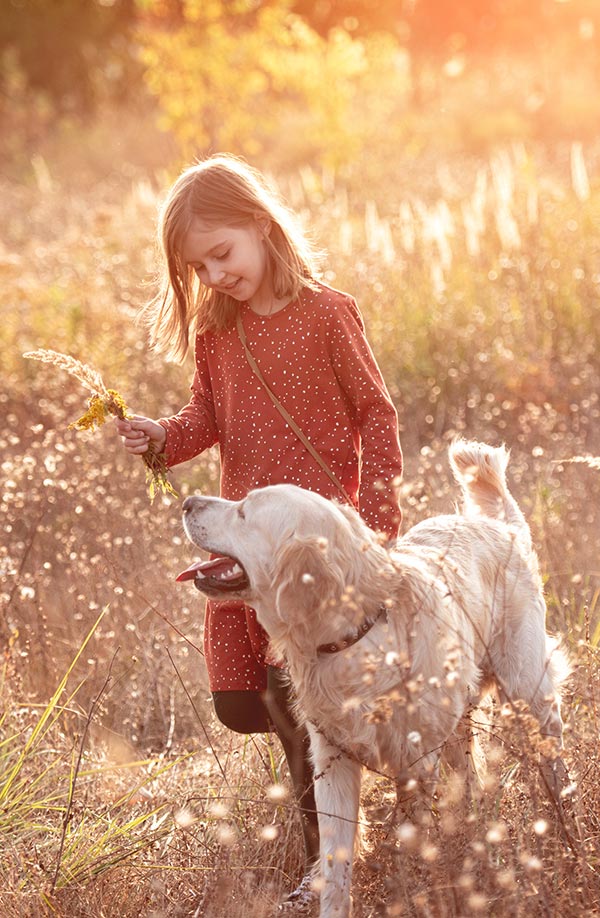Train Without Pain Resource Library
Kid Friendly Bonding Activities with Dogs
Dogs and kids both love to play, but unstructured play can sometimes get rough or can become too much for either the dogs or the children. When dogs and children are interacting there should always be at least one adult providing full, awake supervision. Here are some activities you can guide your children through to engage and bond with the family dog:
- Find It. Teaching dogs to find a treat can be a fun and mentally stimulating activity. You can start out easy by having your child say, “Find it” and then toss a tasty treat a short distance from the dog. As the dog picks up on the game, you can make it more challenging by tossing the treat in difference directions! If your dog is over the top excited about food and there is any concern about jumping up or snatching, place a baby gate between the dog and kid – this way your child can still toss treats to the dog without any danger of the dog accidentally knocking him or over or nipping at him.
- Fetch. Similar to “Find It,” playing fetch is another fun, contact-free game for dogs and kids to play together. Dogs playing fetch with little ones should already have a good “drop” or be able to engage in “two toy play” (the dog chases one ball and the thrower produces a second ball when they return, eliminating the need to attempt to remove the ball from the dog’s mouth.) If not, than an adult can act as the intermediary between dog and child and hand the ball to the child after the dog has retrieved it – a child should never attempt to remove anything from a dog’s mouth. For dogs that are over-the-top excited about toys, place a gate between the dog and child to avoid any risk of your kiddo being knocked down or otherwise injured.
- Hide and seek. Playing hide and seek is not only fun, but it’s also a great game for practicing recall! Begin by having one parent hang on to the dog or put him in a stay, while the kid goes and hides with a few yummy treats in hand (and with another adult for smaller children or families with particularly exuberant dogs). Once the kid is “hidden” (make it easy for the dog at first!) they can yell out the dog’s name. The adult can tell the dog to, “Go find (child)” and let go or release the pooch. When the dog finds the kid, she can shower him with praise and give him a few treats! A great game both indoors and out! Note: this is only appropriate with dogs that are comfortable around children and take treats gently.
- Enrichment prep. Some dogs may not want a lot of engagement or activity with the young humans of the household, and that’s okay. We can respect our dog’s space while still finding creative ways for kids to feel included in dog ownership. One fun way to do this is to include your children in preparing enrichment items. Stuffing KONGS, crumpling treats in packing paper or cardboard boxes for dogs to “hunt,” creating crazy concoctions to freeze into pupsicles, or filling treat-dispensing toys are all ways that kids can be a part of making something that their dog will enjoy.
- Parent guided petting. It takes a long time to develop the dexterity and physical control needed to safely pet a dog. Toddlers especially will go through periods of wanting to pinch or grab onto things as they explore the world. During this stage, when little ones want to pet the dog, hand over hand petting is a great way to practice. Mom or Dad hold the child’s hand and gently guides him in petting the dog. This, of course, is only recommended with a relaxed dog that has shown no discomfort around the child, and has been invited over to participate in petting time, with the option to remove herself at any time. Another great activity at this age is to practice appropriately petting a stuffed animal.
- Participating in training. Older children may express interest in participating in the dog’s training. Training can be a great way to bond with the family dog and kids are always welcome to join in training classes! Keep in mind that new skills should be taught by an adult to avoid frustration, but kids can make great training assistants and can help by setting up the training area, tossing treats, and can definitely help practice known behaviors.
